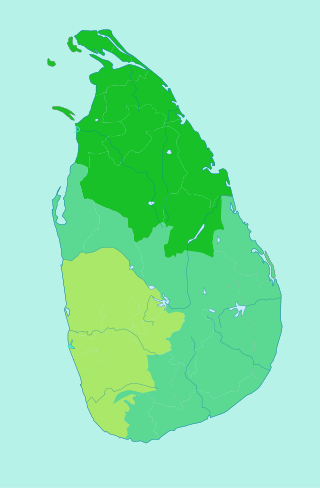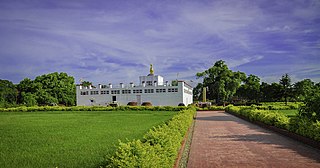This is a list of Maya Rata monarchs. Maya Rata, also known as the Kingdom of Kelaniya, was a medieval era Sinhalese kingdom located in Western part of Sri Lanka.
This is a list of Maya Rata monarchs. Maya Rata, also known as the Kingdom of Kelaniya, was a medieval era Sinhalese kingdom located in Western part of Sri Lanka.
| Portrait | Name | Birth | Death | King From | King Until | Relationship with Predecessor(s) |
|---|---|---|---|---|---|---|
| Yatala Tissa | - | - | - BC | 205 BC | ||
| Kelani Tissa | - | - | 205 BC | 161 BC | ||
Rata may refer to:

Rata Blanca is an Argentine heavy metal band, formed in 1986.

Jüri Ratas is an Estonian politician who was the 18th prime minister of Estonia from 2016 to 2021. He was the Leader of the Centre Party from 2016 to 2023, and was the mayor of Tallinn from 2005 to 2007.
Pro rata is an adverb or adjective meaning in equal portions or in proportion. The term is used in many legal and economic contexts. The hyphenated spelling pro-rata for the adjective form is common, as recommended for adjectives by some English-language style guides. In American English this term has been vernacularized to prorated or pro-rated.

Districts are the second level administrative divisions of Sri Lanka, preceded by provinces. Sri Lanka has 25 districts organized into 9 provinces. Districts are further divided into a number of divisional secretariats, which are in turn subdivided into 14,022 grama niladhari divisions. There are 331 DS divisions in Sri Lanka.
The traditional Maya or Mayan religion of the extant Maya peoples of Guatemala, Belize, western Honduras, and the Tabasco, Chiapas, Quintana Roo, Campeche and Yucatán states of Mexico is part of the wider frame of Mesoamerican religion. As is the case with many other contemporary Mesoamerican religions, it results from centuries of symbiosis with Roman Catholicism. When its pre-Hispanic antecedents are taken into account, however, traditional Maya religion has already existed for more than two and a half millennia as a recognizably distinct phenomenon. Before the advent of Christianity, it was spread over many indigenous kingdoms, all with their own local traditions. Today, it coexists and interacts with pan-Mayan syncretism, the 're-invention of tradition' by the Pan-Maya movement, and Christianity in its various denominations.

Gampola is a town located in Kandy District, Central Province, Sri Lanka, governed by an Urban Council. Gampola was made the capital of the island by King Buwanekabahu IV, who ruled for four years in the mid-fourteenth century. The last king of Gampola was King Buwanekabahu V, who ruled the island for 29 years. A separate city was built in Kotte during this time by a noble known as Alagakkonara. The longest sleeping Buddha statue in South Asia is located in the Saliyalapura Temple, Gampola.

The Maya civilization was a Mesoamerican civilization that existed from antiquity to the early modern period. It is known by its ancient temples and glyphs (script). The Maya script is the most sophisticated and highly developed writing system in the pre-Columbian Americas. The civilization is also noted for its art, architecture, mathematics, calendar, and astronomical system.

Héctor Walter Giardino is an Argentine guitarist and the leader of the heavy metal and hard rock band Rata Blanca.

Sri Lanka is divided into 9 provinces, which are further subdivided into 25 districts. Districts are further subdivided into Divisional Secretary's Divisions. Each DS Division is divided into Grama Niladhari Divisions.
Kavan Tissa, also known as Kavantissa, Kaha Wan Thissa,(that means who has the color of golden body) or Kaka Wanna Tissa,( that means who has black skin tone like a crow). was the king of the Kingdom of Ruhuna in the southern part of Sri Lanka. He ruled Ruhuna, in the same time as Kelani Tissa of Maya Rata and the usurping Tamil king of Anuradhapura, Ellalan of South India, who was projecting power from the Rajarata region across the island of Sri Lanka. Kavan Tissa was a great-grandson of King Devanampiyatissa's youngest brother Mahanaga, and also the father of the King Dutugemunu.

Malaya Rata is the mountain areas of central Sri Lanka.

The Maya Rata (Principality of), also known as the Kingdom of Dakkinadesa, was a principality or an administrative region of the Sinhalese kingdom. It was located in the Southwestern part of Sri Lanka, bordered the Deduru Oya. Its last capital was Parakramapura. The principality was disbanded following the formation of the second kingdom of Polonnaruwa by Parakramabahu I.

The Anuradhapura period was a period in the history of Sri Lanka of the Anuradhapura Kingdom from 377 BCE to 1017 CE. The period begins when Pandukabhaya, King of Upatissa Nuwara moved the administration to Anuradhapura, becoming the kingdom's first monarch. Anuradhapura is heralded as an ancient cosmopolitan citadel with diverse populations.

Maya cities were the centres of population of the pre-Columbian Maya civilization of Mesoamerica. They served the specialised roles of administration, commerce, manufacturing and religion that characterised ancient cities worldwide. Maya cities tended to be more dispersed than cities in other societies, even within Mesoamerica, as a result of adaptation to a lowland tropical environment that allowed food production amidst areas dedicated to other activities. They lacked the grid plans of the highland cities of central Mexico, such as Teotihuacán and Tenochtitlan. Maya kings ruled their kingdoms from palaces that were situated within the centre of their cities. Cities tended to be located in places that controlled trade routes or that could supply essential products. This allowed the elites that controlled trade to increase their wealth and status. Such cities were able to construct temples for public ceremonies, thus attracting further inhabitants to the city. Those cities that had favourable conditions for food production, combined with access to trade routes, were likely to develop into the capital cities of early Maya states.

Rajarata [rā dja ra tə] was one of three historical regions of the island of Sri Lanka for about 1,700 years from the 6th century BCE to the early 13th century CE. Several ancient cities, including Tambapanni, Upatissa Nuwara, Anuradhapura and Polonnaruwa, were established as capitals within the area by successive rulers. Rajarata was under the direct administration of the King. Two other areas, Malayarata and Ruhunurata, were ruled by the king's brothers "Mapa" and "Epa". The Magha invasion in the 13th century brought about the end of the Rajarata kingdom.

Maya Devi Temple is an ancient Buddhist temple situated at the UNESCO World Heritage Site of Lumbini, Nepal. It is the main temple at Lumbini, a site traditionally considered the birthplace of Gautama Buddha. The temple stands adjacent to a sacred pool and a sacred garden. The archaeological remains at the site were previously dated to the third-century BCE brick buildings constructed by Ashoka. A sixth-century BCE timber shrine was discovered in 2013.

House of Siri Sanga Bo was a powerful dynasty which ruled parts of Sri Lanka from Vijayabahu III of Dambadeniya (1220–1224) until Rajasinha I of Sitawaka (1581–1591). Vijayabahu III of Dambadeniya routed Kalinga Magha's armies from Maya Rata and established his fortress at Dambadeniya. This dynasty was able to protect their independence by facing so many foreign invasions thereafter. They had to change their capital city to Dambadeniya, Yapahuwa and Kurunagala because of continuous invasions from southern India.

Malayan invasions of Sri Lanka occurred in the mid-13th century, when the Malayan ruler Chandrabhanu Sridhamaraja of Tambralinga, invaded Sri Lanka twice during the reign of king Parakramabahu II of Dambadeniya. Both invasions were successfully repulsed by the Kingdom of Dambadeniya.
1157 Ruhuna Rebellion, also known as the Rebellion of Queen Sugala, was a revolt led-by Queen Sugala of Ruhuna against the Kingdom of Polonnaruwa ruled by Parakramabahu the Great. The rebellion was suppressed by the army of Parakramabahu, and the kingdom of Ruhuna was annexed as a part of Polonnaruwa in 1158.